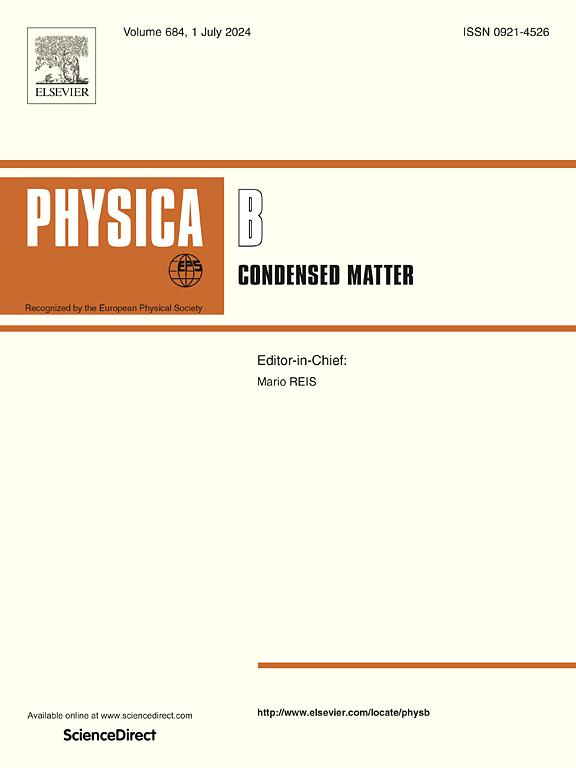CBD-synthesized Mg-doped CdS thin films for hybrid solar cells and self-powered photodetectors
IF 2.8
3区 物理与天体物理
Q2 PHYSICS, CONDENSED MATTER
引用次数: 0
Abstract
Mg-doped CdS samples were deposited via chemical bath deposition onto fluorine-doped tin oxide slides with varying levels of Mg-doping. Structural analysis revealed improved crystal quality in CdS films upon Mg incorporation. Morphological examinations indicated a reduction in grain size alongside appearance of smooth, void-free surfaces particularly evident at 3 % Mg-doping. Mg-doping also resulted in enhanced transparency of CdS films, notably at 3 % and 5 % within the visible spectrum. Efficient exciton dissociation was observed in hybrid solar cells based on 1 % and 3 % Mg-doped CdS, as evidenced by photoluminescence. Top-performing solar cell achieved an efficiency of 0.220 %, nearly seven times that of control device. 5 % Mg-doped CdS-based photodetectors exhibited favorable photosensing characteristics: a responsivity of 0.011 A/W, detectivity of 4.4 × 108 Jones, external quantum efficiency of 3.1 %, and rise/decay times of 26/25 ms at zero bias. These findings underscore beneficial effects of Mg-doping on both hybrid solar cell and self-driven photodetector performance.
用于混合太阳能电池和自供电光电探测器的 CBD 合成掺镁 CdS 薄膜
掺杂镁的 CdS 样品是通过化学沉积法沉积在掺氟氧化锡载玻片上的,掺杂镁的程度各不相同。结构分析表明,掺入镁后,CdS 薄膜的晶体质量得到改善。形态学检查显示,晶粒尺寸减小,表面光滑无空隙,这在掺镁 3% 时尤为明显。掺镁还提高了 CdS 薄膜的透明度,尤其是在 3% 和 5% 的可见光谱范围内。光致发光证明,在基于 1% 和 3% 掺镁 CdS 的混合太阳能电池中观察到了高效的激子解离。性能最好的太阳能电池的效率达到了 0.220%,几乎是对照装置的七倍。基于 5 % 掺镁 CdS 的光电探测器表现出良好的光敏特性:响应率为 0.011 A/W,检测率为 4.4 × 108 Jones,外部量子效率为 3.1 %,零偏压下的上升/衰减时间为 26/25 ms。这些发现强调了掺镁对混合太阳能电池和自驱动光电探测器性能的有利影响。
本文章由计算机程序翻译,如有差异,请以英文原文为准。
求助全文
约1分钟内获得全文
求助全文
来源期刊

Physica B-condensed Matter
物理-物理:凝聚态物理
CiteScore
4.90
自引率
7.10%
发文量
703
审稿时长
44 days
期刊介绍:
Physica B: Condensed Matter comprises all condensed matter and material physics that involve theoretical, computational and experimental work.
Papers should contain further developments and a proper discussion on the physics of experimental or theoretical results in one of the following areas:
-Magnetism
-Materials physics
-Nanostructures and nanomaterials
-Optics and optical materials
-Quantum materials
-Semiconductors
-Strongly correlated systems
-Superconductivity
-Surfaces and interfaces
 求助内容:
求助内容: 应助结果提醒方式:
应助结果提醒方式:


